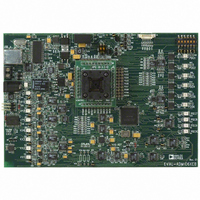EVAL-ADM1063TQEBZ Analog Devices Inc, EVAL-ADM1063TQEBZ Datasheet - Page 26

EVAL-ADM1063TQEBZ
Manufacturer Part Number
EVAL-ADM1063TQEBZ
Description
BOARD EVALUATION FOR ADM1063TQ
Manufacturer
Analog Devices Inc
Specifications of EVAL-ADM1063TQEBZ
Main Purpose
Power Management, Power Supply Supervisor/Tracker/Sequencer
Embedded
No
Utilized Ic / Part
ADM1063
Primary Attributes
10 Channel Supervisor / Sequencer, 6 Voltage Output DACs
Secondary Attributes
GUI Programmable via SMBus (via USB)
Lead Free Status / RoHS Status
Lead free / RoHS Compliant
ADM1063
The device also has several identification registers (read-only)
that can be read across the SMBus. Table 12 lists these registers
with their values and functions.
Table 12. Identification Register Values and Functions
Name
MANID
REVID
MARK1
MARK2
General SMBus Timing
Figure 34, Figure 35, and Figure 36 are timing diagrams for
general read and write operations using the SMBus. The SMBus
specification defines specific conditions for different types of
read and write operations, which are discussed in the Write
Operations and Read Operations sections.
The general SMBus protocol operates as follows:
Step 1
The master initiates data transfer by establishing a start condition,
defined as a high-to-low transition on the serial data-line SDA
while the serial clock-line SCL remains high. This indicates that
a data stream follows. All slave peripherals connected to the serial
bus respond to the start condition and shift in the next eight bits,
consisting of a 7-bit slave address (MSB first) plus an R/ W bit.
This bit determines the direction of the data transfer, that is,
whether data is written to or read from the slave device (0 = write,
1 = read).
The peripheral whose address corresponds to the transmitted
address responds by pulling the data line low during the low
period before the ninth clock pulse, known as the acknowledge
bit, and by holding it low during the high period of this clock pulse.
Address
0xF4
0xF5
0xF6
0xF7
(CONTINUED)
(CONTINUED)
SDA
SCL
START BY
SDA
MASTER
SCL
Value
0x41
0x02
0x00
0x00
1
0
Manufacturer ID for Analog Devices
Silicon revision
Software brand
Software brand
Function
1
D7
0
D6
SLAVE ADDRESS
1
FRAME 1
D5
1
D4
1
DATA BYTE
FRAME 3
A1
D3
Figure 34. General SMBus Write Timing Diagram
A0
D2
R/W
ACK. BY
D1
SLAVE
Rev. B | Page 26 of 32
9
D0
ACK. BY
SLAVE
1
9
D7
D6
1
All other devices on the bus remain idle while the selected device
waits for data to be read from or written to it. If the R/ W bit is a 0,
the master writes to the slave device. If the R/ W bit is a 1, the
master reads from the slave device.
Step 2
Data is sent over the serial bus in sequences of nine clock pulses:
eight bits of data followed by an acknowledge bit from the slave
device. Data transitions on the data line must occur during the low
period of the clock signal and remain stable during the high period
because a low-to-high transition when the clock is high could be
interpreted as a stop signal. If the operation is a write operation,
the first data byte after the slave address is a command byte. This
command byte tells the slave device what to expect next. It may be
an instruction telling the slave device to expect a block write, or
it may be a register address that tells the slave where subsequent
data is to be written. Because data can flow in only one direction,
as defined by the R/ W bit, sending a command to a slave device
during a read operation is not possible. Before a read operation,
it may be necessary to perform a write operation to tell the slave
what sort of read operation to expect and/or the address from
which data is to be read.
Step 3
When all data bytes have been read or written, stop conditions
are established. In write mode, the master pulls the data line high
during the 10th clock pulse to assert a stop condition. In read
mode, the master device releases the SDA line during the low
period before the ninth clock pulse, but the slave device does
not pull it low. This is known as a no acknowledge. The master
then takes the data line low during the low period before the
10th clock pulse and then high during the 10th clock pulse to
assert a stop condition.
D7
D5
COMMAND CODE
D4
D6
FRAME 2
D5
D3
D4
DATA BYTE
D2
FRAME N
D3
D1
ACK. BY
D2
D0
SLAVE
9
D1
D0
ACK. BY
SLAVE
9
MASTER
STOP
BY


















